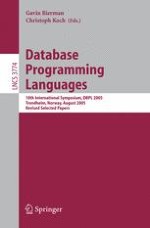2005 | Book
Database Programming Languages
10th International Workshop, DBPL 2005, Trondheim, Norway, August 28-29, 2005, Revised Selected Papers
Editors: Gavin Bierman, Christoph Koch
Publisher: Springer Berlin Heidelberg
Book Series : Lecture Notes in Computer Science
